Identification of the Components of Lacquered Leather Armor from the Warring States Period
Abstract
1. Introduction
2. Materials and Methods
2.1. Sample Preparation
2.2. Analytical Methods
2.2.1. Microscopic Observation
2.2.2. SEM-EDS Analysis
2.2.3. FTIR Analysis
2.2.4. Raman Spectroscopy
2.2.5. Py-GC/MS Analysis
3. Results and Discussion
3.1. Structural Analysis of the Lacquered Armor
3.2. Analysis of the Substrate Material
3.3. Lacquer Film Analysis
3.4. Technological Reconstruction
3.5. Conservation Considerations
4. Conclusions
- (1)
- The lacquered armor sample is generally well-preserved in shape; however, the lacquer surface exhibits typical signs of aging, including warping, blistering, fragmentation, and cracking, indicating significant physical deterioration during burial.
- (2)
- The substrate was identified as animal leather. The remaining fibrous material on the reverse side shows uneven coloration, a loose and degraded structure, and a rough, furrowed appearance at the base lacquer layer, all of which point to a high degree of degradation.
- (3)
- The brown and black lacquer layers display coloration consistent with the natural tone of raw lacquer (urushi), with no evidence of added carbon-based black pigments. Cinnabar (HgS) was identified as the red pigment in localized red lacquer layers. Combined results from FTIR, Raman spectroscopy, and Py-GC/MS confirm that natural raw lacquer was the primary film-forming material.
- (4)
- Structurally, the armor was produced by repeatedly applying alternating brown and black lacquer layers directly onto the leather substrate. The lacquer layers differ in thickness and texture, with selective application of red decorative coatings. This multilayer lacquering approach not only enhanced the mechanical strength and protective function of the armor but also reflects a high degree of technological continuity and standardization in lacquered armor production during the Warring States period.
Author Contributions
Funding
Institutional Review Board Statement
Informed Consent Statement
Data Availability Statement
Acknowledgments
Conflicts of Interest
References
- Li, Z.; Li, X.; Yu, J.; Sun, Y.; Geng, J.; Zhao, X. The Lacquer Craft of the Corridor Coffin (徼道棺) from Tomb No. 2 of Tushan in Eastern Han Dynasty, Xuzhou. Coatings 2024, 14, 1222. [Google Scholar] [CrossRef]
- Zhai, K.; Sun, G.; Zheng, Y.; Wu, M.; Zhang, B.; Zhu, L.; Hu, Q. The earliest lacquerwares of China were discovered at Jingtoushan site in the Yangtze River Delta. Archaeometry 2022, 64, 218–226. [Google Scholar] [CrossRef]
- Hidaka, K.; Werhahn, S.Y. Lacquerware as a Global Commodity: Distribution and Imitation of Maki-e. In Japanese Art—Transcultural Perspectives; Brill: Leiden, The Netherlands, 2024; pp. 279–303. [Google Scholar]
- Sangchel, S. A study on the inflow routes and utilization of East Asian lacquerware in the art market of France during the 17th and 18th centuries. Misuljaryo-Natl. Mus. Korea Art J. 2022, 102, 38–64. [Google Scholar]
- Hong, S. A review of a century of archaeological research on ancient Chinese lacquerware. South. Cult. Relics 2021, 4, 48–54. [Google Scholar]
- Romero, R.; Illán, A.; Bondía, C. Three studies of luxury Mexican lacquer objects from the 16th to the 19th centuries: Analysis of materials and pictorial techniques. Heritage 2023, 6, 3590–3605. [Google Scholar] [CrossRef]
- Wu, F.; Zhang, L.; Chen, J. A study on the manufacturing process of Song Dynasty lacquerware with circle-overlapping method. In Collection of Papers on Museum Scientific Research; Chengyuan, M., Ed.; Shanghai Science and Technology Literature Press: Shanghai, China, 1996; p. 460. [Google Scholar]
- Lu, R.; Honda, T.; Kamiya, Y.; Yoshida, K.; Miyakoshi, T. Analysis of Japanese Jōmon lacquerware by pyrolysis-gas chromatography/mass spectrometry. J. Anal. Appl. Pyrolysis 2013, 103, 68–72. [Google Scholar] [CrossRef]
- Park, J.; Choi, J.; Lee, U.; Kang, M.; Kim, S. Lacquer techniques in the late Joseon dynasty. J. Korean Wood Sci. Technol. 2023, 51, 69–80. [Google Scholar] [CrossRef]
- Norman, J. Lacquer: Technology and Conservation: A Comprehensive Guide to the Technology and Conservation of Asian and European Lacquer; Archetype Publications: London, UK, 2006. [Google Scholar]
- He, H.P.; Hu, T. Exploration on the Development of Ancient Armor; Capital Museum Forum: Beijing, China, 2014; pp. 9–15. [Google Scholar]
- Zhang, Y.; Xu, J.J. Analysis of the manufacturing technology of Warring States lacquered leather armor unearthed in Nanyang, Henan. Jianghan Archaeol. 2014, S1, 135–143. [Google Scholar]
- Rong, B.; Zhao, Q.; Wu, Z.-J.; Zheng, H.; Zhao, J.; Luo, H.-J.; Li, Q.; Ma, Y.-R. Scientific research on painted pottery from the Warring States Chu tomb at Chengyangcheng site, Xinyang, Henan. Sci. Conserv. Archaeol. 2018, 30, 9–14. [Google Scholar]
- Feng, D.J.; Wu, Z.J.; Zhao, J.F.; Li, J.J. Study on wood materials from Tomb No. 8 at Chengyangcheng site, Xinyang, Henan. J. Northwest For. Univ. 2017, 32, 245–248. [Google Scholar]
- Jia, L.M.; Wu, Z.J.; Zhang, L.; Lu, H.W.; Ma, M. Major achievements of archaeological work at Chengyangcheng site, Xinyang City, Henan from 2009 to 2011. Huaxia Archaeol. 2014, 2, 3–9. [Google Scholar]
- Wu, Z.J.; Nie, F.; Ren, X.; Ma, M.; Kou, J.; Jia, L. Excavation brief of Tomb No. 8 at Chengyangcheng site, Xinyang City, Henan. Huaxia Archaeol. 2020, 4, 24–45. [Google Scholar]
- Li, Y.H.; Yang, L.; Ge, R.C. Interaction and stability of protein-based mixed adhesives in painted cultural relics. Spectrosc. Spectr. Anal. 2024, 44, 1946–1951. [Google Scholar]
- Zhang, C.; Ge, R.; Yang, J.; Huang, J.; Dou, H.; Li, X.; Yang, L. The forgotten framework: Analysis of organic residues on Bronze Harness Ornaments of Shang and Western Zhou Dynasties unearthed at Xitou site in Shaanxi, China. npj Herit. Sci. 2025, 13, 9. [Google Scholar] [CrossRef]
- Wang, R.; Nie, F.; Chen, J.M.; Zhu, Y. Studies on lacquerwares from between the mid-Warring States period and the mid-Western Han dynasty excavated in the Changsha region. Archaeometry 2017, 59, 547–565. [Google Scholar] [CrossRef]
- Colomban, P.; Mancini, D. Lacquerware pigment identification with fixed and mobile raman microspectrometers: A potential technique to differentiate original/fake artworks. Arts 2013, 2, 111–123. [Google Scholar] [CrossRef]
- Niimura, N.; Miyakoshi, T. Structural study of oriental lacquer films during the hardening process. Talanta 2006, 70, 146–152. [Google Scholar] [CrossRef]
- Frade, J.C.; Ribeiro, M.I.; Graça, J.; Rodrigues, J. Applying pyrolysis-gas chromatography/mass spectrometry to the identification of oriental lacquers: Study of two lacquered shields. Anal. Bioanal. Chem. 2009, 395, 2167–2174. [Google Scholar] [CrossRef]
- Ebert, B.; Schilling, R.M. A technical analysis of paint media used in twentieth-century Vietnamese lacquer paintings. Stud. Conserv. 2016, 61 (Suppl. S3), 52–67. [Google Scholar] [CrossRef]
- Zhao, X.; Wang, L.; Guo, L.; Ma, Y.; Wang, Z.; Niu, Q.; Zheng, L. Synthesis and thermal decomposition kinetics of moisture curable polyurethane films as a reinforcing material for cultural relics. Sci. Rep. 2020, 10, 21724. [Google Scholar] [CrossRef]
- Zhao, X.; Wang, L.; Guo, L.; Ma, Y.; Wang, Z.; Niu, Q. The effect of a hindered amine light stabilizer on the aging behavior of moisture-curable polyurethane as a cultural relics consolidant. Polimery 2020, 65, 297–303. [Google Scholar] [CrossRef]
- Zhao, X.; Wang, L.; Zhao, X.; Qian, Y.; Tang, Y.; Dong, X. Synthesis, testing and application of moisture-curable polyurethane as a consolidant for fragile organic cultural objects. J. Adhes. Sci. Technol. 2018, 32, 2421–2428. [Google Scholar] [CrossRef]
- Zhao, X.; Li, X.Z.; Xie, X.W.; Wang, L.Q.; Guo, L.; Leng, X.; Niu, Q. Performance characterization of moisture-curable polyurethane for cultural relic reinforcement. Appl. Chem. Ind. 2025, 54, 821–825. [Google Scholar]
- Huang, X.; Chen, J.C.; Chen, S.Y.; Shen, C.Y. Microstructure and interaction of soil matrix reinforced by a novel material. Appl. Mech. Mater. 2012, 174–177, 954–957. [Google Scholar] [CrossRef]
- Chen, J.; Mai, Y.; Chen, L.; Zhang, L.; Cui, X.; Liu, X. Evaluation of Surface Stabilization and Reinforcement Effect of Fragile Bronzes. J. Phys. Conf. Ser. 2024, 2706, 012019. [Google Scholar]
- Chen, J.C.; Huang, X.; Liu, H.W.; Zhu, R.S. Reinforcement experiment of Dazu Grotto sandstone samples with acrylate complex sol. Cult. Herit. Conserv. 2015, 38–42. [Google Scholar]
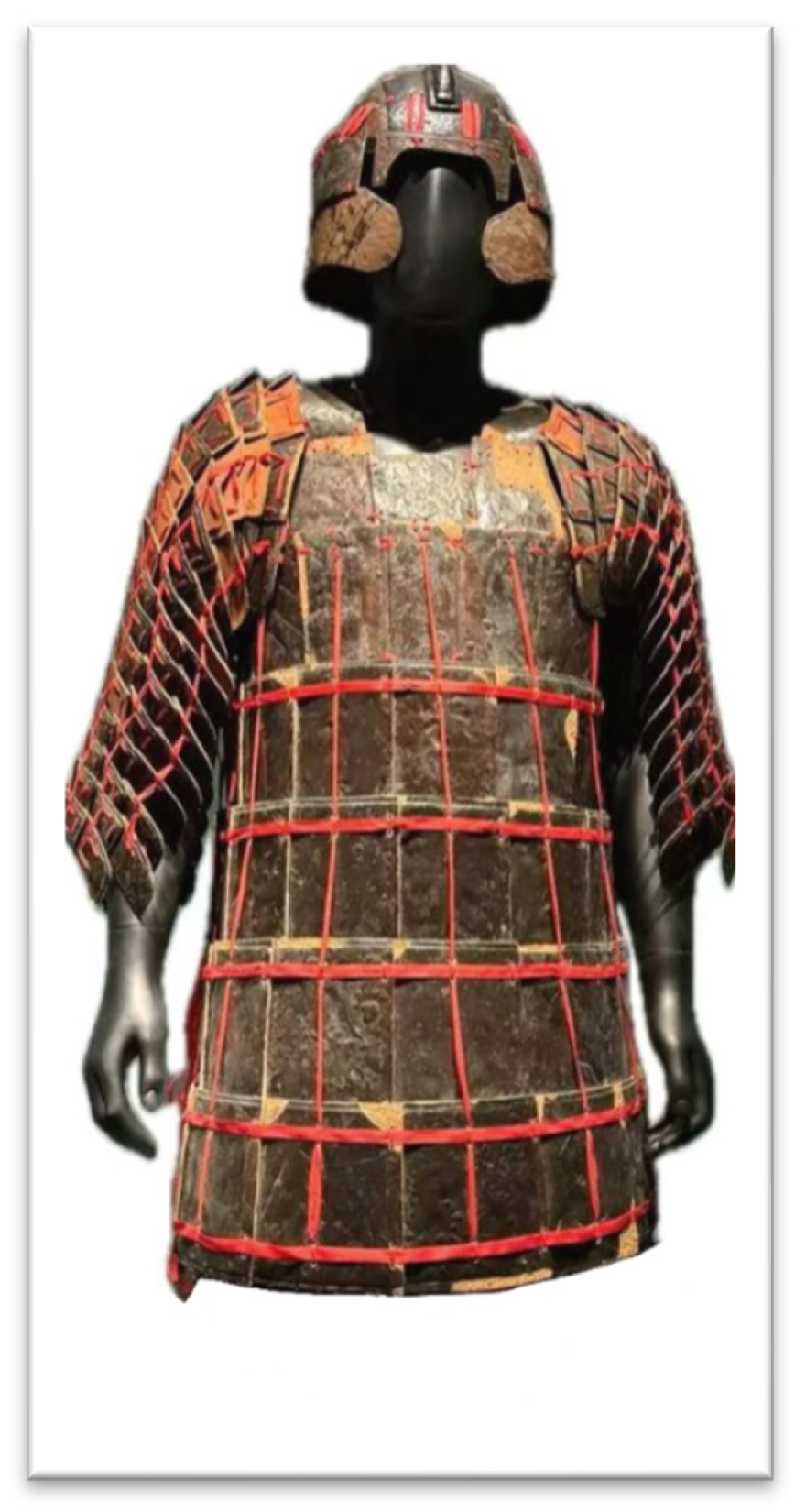


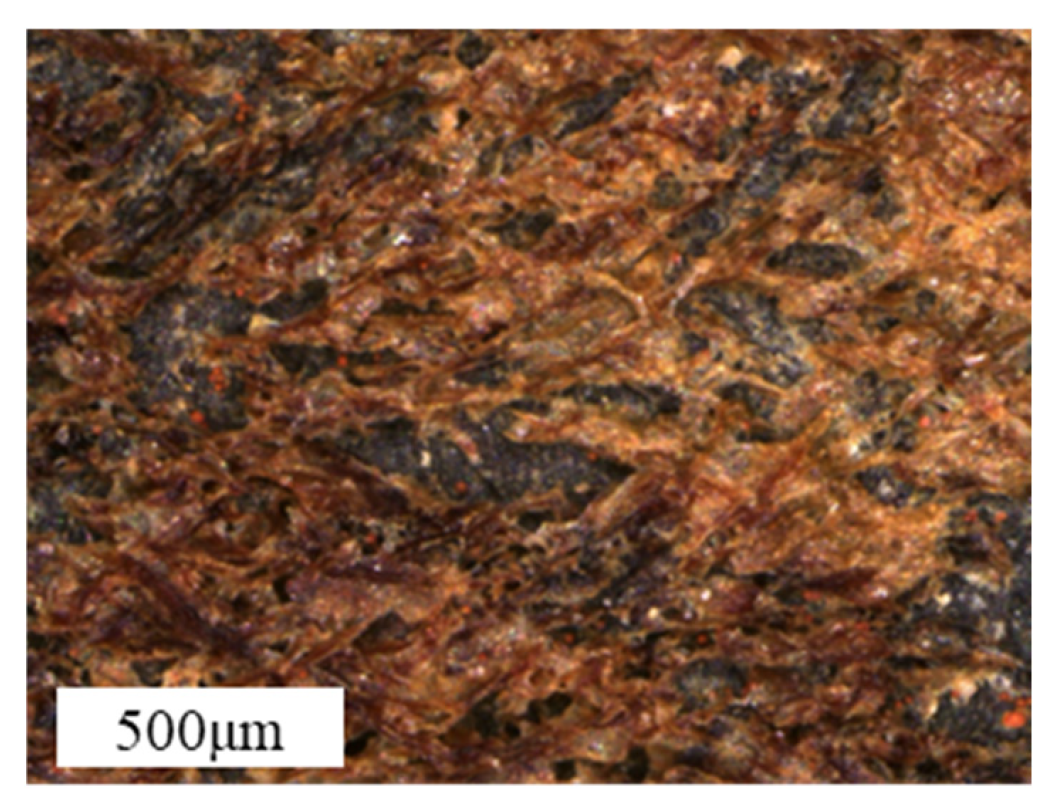
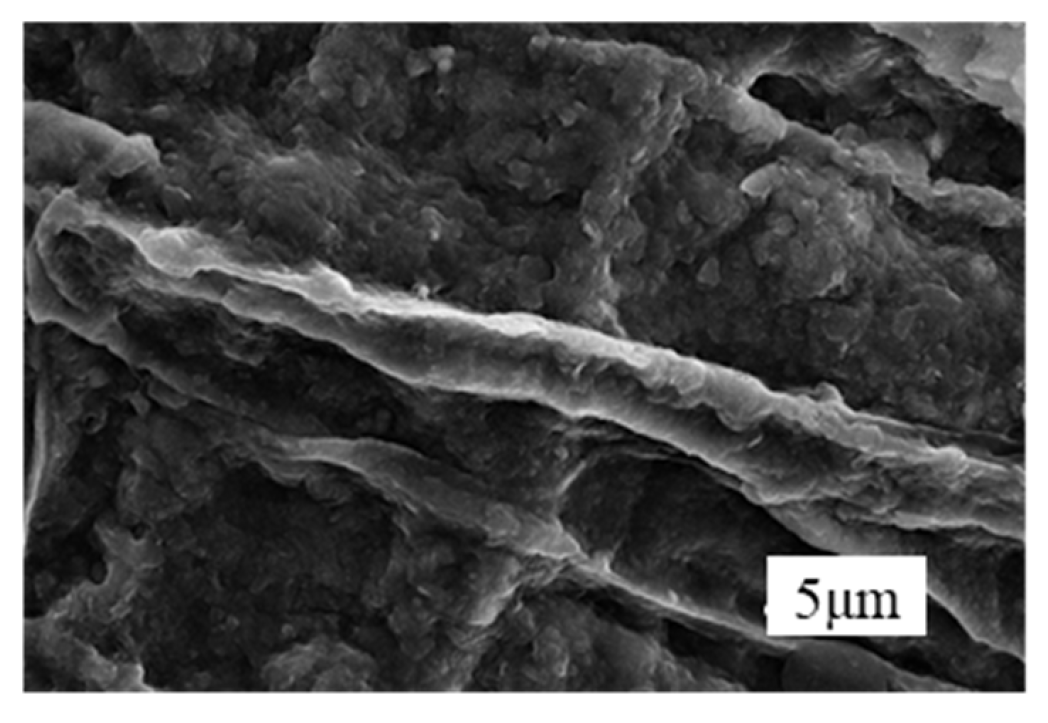

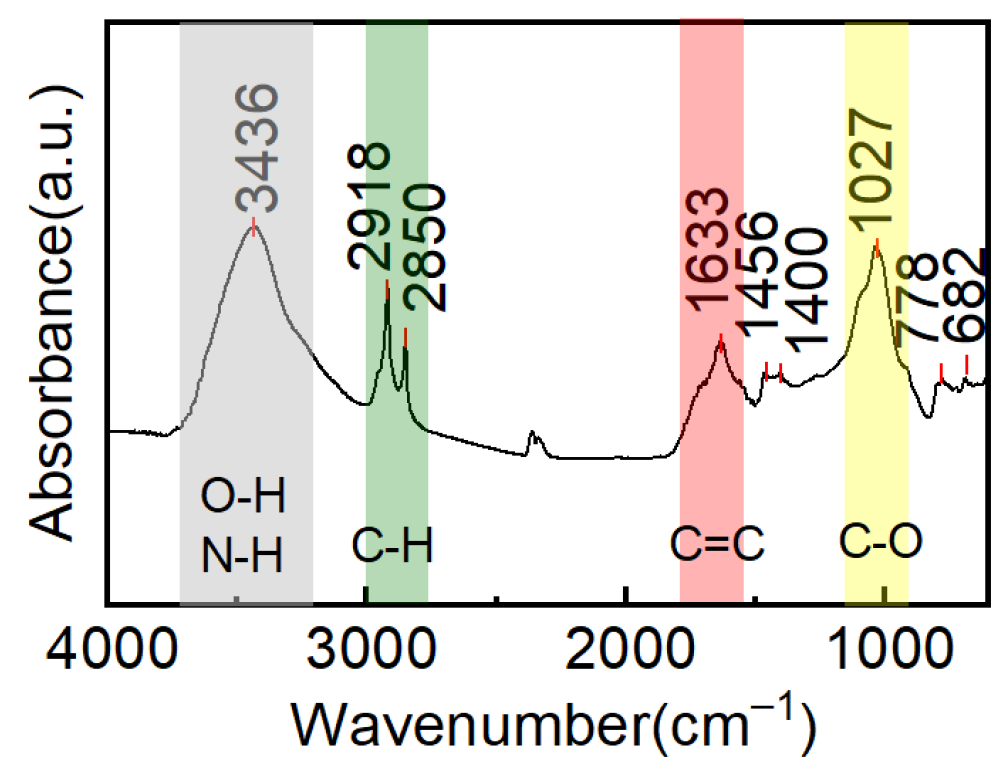

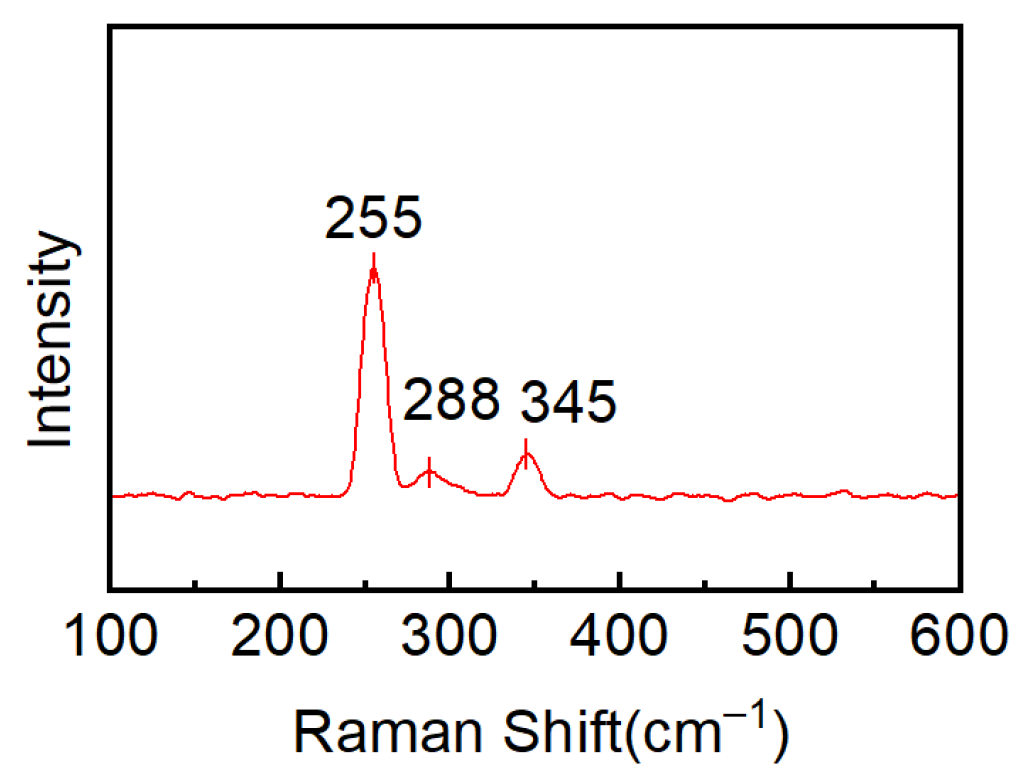
| Wavenumber (cm−1) | Vibration Type and Group | Group Assignment |
|---|---|---|
| 3436 | O–H symmetric stretching vibration | Hydroxyl groups on the benzene ring |
| 2918 | C–H asymmetric stretching vibration | Methylene groups in the long side chain |
| 2850 | C–H symmetric stretching vibration | Methylene groups in the long side chain |
| 1633 | C=C stretching vibration | Aromatic ring skeleton in urushiol |
| 1456 | C–H bending vibration | Methylene groups in the long side chain |
| 1027 | C–O stretching vibration | Carbon–oxygen bonds in urushiol |
| 778 | In-plane bending of ortho-disubstituted benzene ring | 3-substituted catechol structure |
| Element | Weight (%) |
|---|---|
| C | 45.2 |
| O | 44.9 |
| Na | 2.5 |
| Mg | 1.0 |
| Ca | 6.6 |
Disclaimer/Publisher’s Note: The statements, opinions and data contained in all publications are solely those of the individual author(s) and contributor(s) and not of MDPI and/or the editor(s). MDPI and/or the editor(s) disclaim responsibility for any injury to people or property resulting from any ideas, methods, instructions or products referred to in the content. |
© 2025 by the authors. Licensee MDPI, Basel, Switzerland. This article is an open access article distributed under the terms and conditions of the Creative Commons Attribution (CC BY) license (https://creativecommons.org/licenses/by/4.0/).
Share and Cite
Liu, X.; Wu, Z.; Chi, M.; Chen, Z.; Guo, L.; Zhao, Z.; Feng, K.; Qin, Y. Identification of the Components of Lacquered Leather Armor from the Warring States Period. Coatings 2025, 15, 1127. https://doi.org/10.3390/coatings15101127
Liu X, Wu Z, Chi M, Chen Z, Guo L, Zhao Z, Feng K, Qin Y. Identification of the Components of Lacquered Leather Armor from the Warring States Period. Coatings. 2025; 15(10):1127. https://doi.org/10.3390/coatings15101127
Chicago/Turabian StyleLiu, Xin, Zhijiang Wu, Ming Chi, Zhen Chen, Lijing Guo, Zichen Zhao, Kai Feng, and Yu Qin. 2025. "Identification of the Components of Lacquered Leather Armor from the Warring States Period" Coatings 15, no. 10: 1127. https://doi.org/10.3390/coatings15101127
APA StyleLiu, X., Wu, Z., Chi, M., Chen, Z., Guo, L., Zhao, Z., Feng, K., & Qin, Y. (2025). Identification of the Components of Lacquered Leather Armor from the Warring States Period. Coatings, 15(10), 1127. https://doi.org/10.3390/coatings15101127






